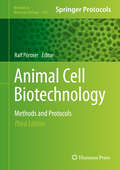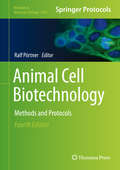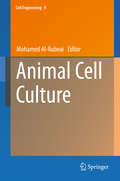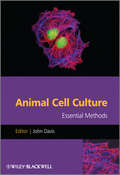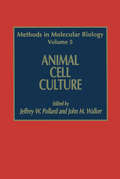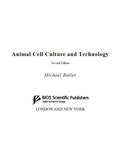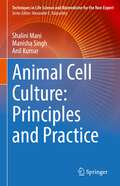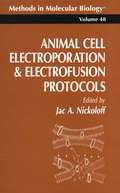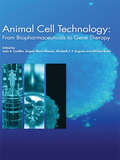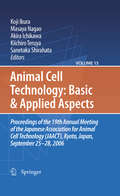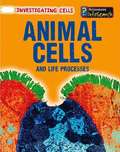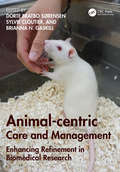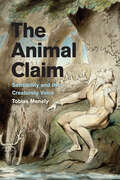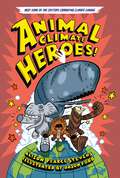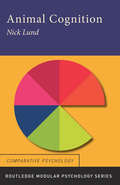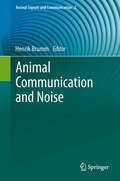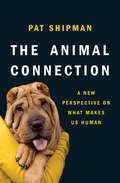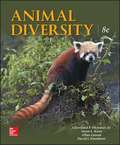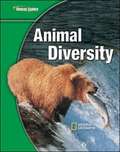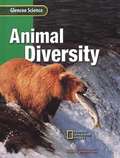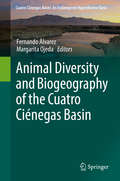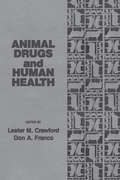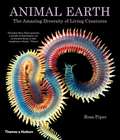- Table View
- List View
Animal Cell Biotechnology: Methods and Protocols (Methods in Molecular Biology #1104)
by Ralf PörtnerThe second edition of this book constitutes a comprehensive manual of new techniques for setting up mammalian cell lines for production of biopharmaceuticals, and for optimizing critical parameters for cell culture considering the whole cascade from lab to final production. The chapters are written by world-renowned experts and the volume's five parts reflect the processes required for different stages of production. This book is a compendium of techniques for scientists in both industrial and research laboratories that use mammalian cells for biotechnology purposes.
Animal Cell Biotechnology: Methods and Protocols (Methods in Molecular Biology #2095)
by Ralf PörtnerAnimal Cell Biotechnology: Methods and Protocols, Fourth Edition constitutes a comprehensive manual of state-of-the-art techniques for setting up mammalian cell lines and media for development of biopharmaceuticals, and optimizing critical parameters for cell culture considering the whole cascade from the lab to the final production. Special emphasis was put on model-assisted concepts. Scientists with long-refined expertise describe cutting-edge techniques for the production of therapeutic proteins and vaccines. Capturing the major advances that have occurred in both science and the technology of these biopharmaceuticals, this important book covers the powerful new techniques used in cell line and media development, optimizing process techniques and process strategies, use of model-assisted tools for process design and optimization, and in analysis. Topics include cell line and media development, techniques for process development, model-based techniques for process development, process analysis, and downstream techniques. The volume is divided into five parts that reflect the processes required for different stages of production. Written in the highly successful Methods in Molecular Biology series format, chapters include introductions to their respective topics, lists of the necessary materials and reagents, step-by-step, readily reproducible laboratory protocols, and tips on troubleshooting and avoiding known pitfalls.Animal Cell Biotechnology: Methods and Protocols, Fourth Edition provides a compendium of techniques for scientists in industrial and research laboratories that use mammalian cells for biotechnology purposes.
Animal Cell Culture (Cell Engineering #9)
by Mohamed Al-RubeaiAnimal cells are the preferred "cell factories" for the production of complex molecules and antibodies for use as prophylactics, therapeutics or diagnostics. Animal cells are required for the correct post-translational processing (including glycosylation) of biopharmaceutical protein products. They are used for the production of viral vectors for gene therapy. Major targets for this therapy include cancer, HIV, arthritis, cardiovascular and CNS diseases and cystic fibrosis. Animal cells are used as in vitro substrates in pharmacological and toxicological studies. This book is designed to serve as a comprehensive review of animal cell culture, covering the current status of both research and applications. For the student or R&D scientist or new researcher the protocols are central to the performance of cell culture work, yet a broad understanding is essential for translation of laboratory findings into the industrial production. Within the broad scope of the book, each topic is reviewed authoritatively by experts in the field to produce state-of-the-art collection of current research. A major reference volume on cell culture research and how it impacts on production of biopharmaceutical proteins worldwide, the book is essential reading for everyone working in cell culture and is a recommended volume for all biotechnology libraries.
Animal Cell Culture
by John M. DavisThis is a comprehensive research guide that describes both the key new techniques and more established methods. Every chapter discusses the merits and limitations of the various approaches and then provides selected tried-and-tested protocols, as well as a plethora of good practical advice, for immediate use at the bench. It presents the most accessible and comprehensive introduction available to the culture and experimental manipulation of animal cells. Detailed protocols for a wide variety of methods provide the core of each chapter, making new methodology easily accessible.This book is an essential laboratory manual for all undergraduates and graduates about to embark on a cell culture project. It is a book which both experienced researchers and those new to the field will find invaluable.
Animal Cell Culture (Methods in Molecular Biology #5)
by John M. Walker Jeffrey W. PollardAnimal Cell Culture, the latest volume in Humana's highly successful Methods in Molecular Biology series, provides detailed practical techniques for the culture of a broad spectrum of basic cell cell types. Chapters offer hands-on methods for creating mammalian fibroblastic cell cultures and maintaining culture conditions for epithelial, neuronal, and hematopoietic cells among others. Attention is given to the diversity of culture media and extracellular matrices needed to maintain the differentiated functions of the cultured cells. The book's special strength lies in its descriptions of culture techniques for both living and fixed cells. Chapters cover techniques such as: * cinematographic analysis * in situ mRNA hybridization * immunofluorescence * immunoelectron microscopy * somatic cell hybridization * DNA transformation * insect cell culture * creation of hybridoma cell lines * monoclonal antibody techniques * new, specialized methodologies. A useful appendix lists the most commonly used culture media. Comprehensive in scope and coverage, and thoroughly up-to-date, Pollard and Walker's unique handbook on ANIMAL CELL CULTURE is an indispensable resource for both the novice and the seasoned expert.
Animal Cell Culture and Technology (THE BASICS (Garland Science))
by Michael ButlerAnimal cell culture is an important laboratory technique in the biological and medical sciences. It has become an essential tool for the study of most biochemical and physiological processes and the use of large-scale animal cell culture has become increasingly important to the commercial production of specific compounds for the pharmaceutical industry. This book describes the basic requirements for establishing and maintaining cell cultures both in the laboratory and in large-scale operations. Minimal background knowledge of the subject is assumed and therefore it will be a readable introduction to animal cell culture for undergraduates, graduates and experienced researchers. Reflecting the latest developments and trends in the field, the new topics include the latest theory of the biological clock of cell lines, the development of improved serum-free media formulations, the increased understanding of the importance and control of protein glycosylation, and the humanization of antibodies for therapeutic use.
Animal Cell Culture: Principles and Practice (Techniques in Life Science and Biomedicine for the Non-Expert)
by Shalini Mani Manisha Singh Anil KumarThis introductory guide provides novice researchers and lab students with a thorough step-by-step approach to standard animal cell culture techniques. Coverage includes lab safety and best practices, sterility management, preparation, ethical considerations, and troubleshooting for common pain points. This is an up-to-date, indispensable handbook for early-career researchers and students, as well as established scientists in biotechnology, cell and developmental biology, pharmaceutical toxicology, cytogenetics, and more.
Animal Cell Electroporation and Electrofusion Protocols (Methods in Molecular Biology #48)
by Jac A. NickoloffThis superb collection of well-tested protocols for the electroporation of proteins and DNA into insect, fish, and mammalian cells also includes proven animal cell electrofusion techniques for studies of somatic cell genetics and development, and for generating monoclonal antibodies. It is distinguished by its coverage of important model cell types from many organisms and tissue types and its detailed instructions for the growth and preparation of specific cells to achieve optimum transfection. Its extensive reference lists, citations of alternative transfer methods, advice on pitfalls to avoid, and descriptions of expected results ensure readily reproducible results even for beginners.
Animal Cell Technology: From Biopharmaceuticals to Gene Therapy
by Leda Castilho Ângela Maria Moraes Elisabeth F. P. Augusto Michael ButlerAnimal Cell Technology: from Biopharmaceuticals to Gene Therapy provides a comprehensive insight into biological and engineering concepts related to mammalian and insect cell technology, as well as an overview of the applications of animal cell technology. Part 1 of the book covers the Fundamentals upon which this technology is based and covers the science underpinning the technology. Part 2 covers the Applications from the production of therapeutic proteins to gene therapy. The authors of the chapters are internationally-recognized in the field of animal cell culture research and have extensive experience in the areas covered in their respective chapters.
Animal Cell Technology: Proceedings of the 19th Annual Meeting of the Japanese Association for Animal Cell Technology (JAACT), Kyoto, Japan, September 25-28, 2006 (Animal Cell Technology: Basic & Applied Aspects #15)
by Koji Ikura Kiichiro Teruya Sanetaka Shirahata Masaya Nagao Akira IchikawaAnimal cell technology is a growing discipline of cell biology which aims not only to understand structures, functions and behaviors of differentiated animal cells, but also to ascertain their abilities to be used for industrial and medical purposes. The goal of animal cell technology includes the clonal expansion of differentiated cells, the optimization of their culture conditions, modulation of their ability to produce proteins of medical and pharmaceutical importantance, and the application of animal cells to gene therapy, artificial organs and the production of functional foods. This volume gives the readers a complete review of the present state-of-the-art and will be useful for those working in either academic environments or in the biotechnology and pharmaceutical sectors, particularly cell biologists, biochemists, molecular biologists, immunologists, biochemical engineers and all other disciplines related to animal cell culture.
Animal Cells And Life Processes (Investigating Cells)
by Barbara Somervill Megan CotugnoThis book explores the features of the animal cell and includes information about life processes such as respiration.
Animal-centric Care and Management: Enhancing Refinement in Biomedical Research
by Dorte Bratbo Sørensen, Sylvie Cloutier, and Brianna N. GaskillThe concept of the 3Rs (Refinement, Reduction and Replacement) has been used as a framework for improving the welfare of laboratory animals for the last half century. By establishing an animal-centric view on housing and management, Animal-centric Care and Management: Enhancing Refinement in Biomedical Research takes Russell and Burch’s definition of Refinement as "elimination of inhumanities" and goes further. Rather than fitting animals into experimental conditions, it encourages readers to adjust conditions to better meet the behavioral, emotional, physical, and physiological needs and preferences of the animals. The team of expert authors, from the fields of laboratory animal science, ethology, biology as well as animal training, provide ideas for creating housing conditions and handling procedures that induce, to the best of current abilities and knowledge, a long-term positive state of mind in the animals under our care. This book is written for animal caretakers, animal health technicians, researchers, animal facility managers, laboratory animal veterinarians, and anyone who engages in work with living experimental animals or is interested in the continuous improvement of laboratory animal welfare. This interdisciplinary guide will act as a catalyst, resulting in multiple viewpoints and fields collaborating to optimize laboratory animal welfare.
The Animal Claim: Sensibility and the Creaturely Voice
by Tobias MenelyDuring the eighteenth century, some of the most popular British poetry showed a responsiveness to animals that anticipated the later language of animal rights. Such poems were widely cited in later years by legislators advocating animal welfare laws like Martin’s Act of 1822, which provided protections for livestock. In The Animal Claim, Tobias Menely links this poetics of sensibility with Enlightenment political philosophy, the rise of the humanitarian public, and the fate of sentimentality, as well as longstanding theoretical questions about voice as a medium of communication. In the Restoration and eighteenth century, philosophers emphasized the role of sympathy in collective life and began regarding the passionate expression humans share with animals, rather than the spoken or written word, as the elemental medium of community. Menely shows how poetry came to represent this creaturely voice and, by virtue of this advocacy, facilitated the development of a viable discourse of animal rights in the emerging public sphere. Placing sensibility in dialogue with classical and early-modern antecedents as well as contemporary animal studies, The Animal Claim uncovers crucial connections between eighteenth-century poetry; theories of communication; and post-absolutist, rights-based politics.
Animal Climate Heroes
by Alison Pearce StevensIn our left corner we have the meanest villain that’s ever existed. Responsible for rising seas and loss of biodiversity, it’s climate change ready to wreak havoc on the Earth. But in our right corner? We have four superheroes ready to save the day!Forest elephants protect our forests by trampling trees.Whales boost ocean health with their massive poo-nados.Sea otters defend kelp forests from purple invaders.And echidnas bury tons of soil to stop climate change.But we can’t leave them in this fight alone. We need to protect our heroes who, in return, defend our planet. Get ready to learn all about these four legged, and two-flippered, creatures and how YOU can be a climate hero too!
Animal Cognition (Routledge Modular Psychology)
by Nick LundAnimal Cognition looks at how non-human animals process information from their environment. Nick Lund has written an accessible and engaging account of this area of comparative psychology. The book contains chapters on animal navigation (including homing behaviour and migration), animal communication methods and research into animal language, and attempts to teach language to non-human animals. A chapter on memory includes models of memory in non-human animals and discusses the importance of memory in navigation and foraging behaviour.Animal Cognition is designed to cover the AQA(A) A2 level specification but will also be of interest to undergraduates new to comparative psychology. It is well illustrated and includes a study aids section with examination questions and answers, and key research summaries.
Animal Communication and Noise (Animal Signals and Communication #2)
by Henrik BrummThe study of animal communication has led to significant progress in our general understanding of motor and sensory systems, evolution, and speciation. However, one often neglected aspect is that signal exchange in every modality is constrained by noise, be it in the transmission channel or in the nervous system. This book analyses whether and how animals can cope with such constraints, and explores the implications that noise has for our understanding of animal communication. It is written by leading biologists working on different taxa including insects, fish, amphibians, lizards, birds, and mammals. In addition to this broad taxonomic approach, the chapters also cover a wide array of research disciplines: from the mechanisms of signal production and perception, to the behavioural ecology of signalling, the evolution of animal communication, and conservation issues. This volume promotes the integration of the knowledge gained by the diverse approaches to the study of animal communication and, at the same time, highlights particularly interesting fields of current and future research.
Animal Communication Theory
by Ulrich E. StegmannThe explanation of animal communication by means of concepts like information, meaning and reference is one of the central foundational issues in animal behaviour studies. This book explores these issues, revolving around questions such as: • What is the nature of information? • What theoretical roles does information play in animal communication studies? • Is it justified to employ these concepts in order to explain animal communication? • What is the relation between animal signals and human language? The book approaches the topic from a variety of disciplinary perspectives, including ethology, animal cognition, theoretical biology and evolutionary biology, as well as philosophy of biology and mind. A comprehensive introduction familiarises non-specialists with the field and leads on to chapters ranging from philosophical and theoretical analyses to case studies involving primates, birds and insects. The resulting survey of new and established concepts and methodologies will guide future empirical and theoretical research.
The Animal Connection: A New Perspective on What Makes Us Human
by Pat ShipmanA bold, illuminating new take on the love of animals that drove human evolution. Why do humans all over the world take in and nurture other animals? This behavior might seem maladaptive--after all, every mouthful given to another species is one that you cannot eat--but in this heartening new study, acclaimed anthropologist Pat Shipman reveals that our propensity to domesticate and care for other animals is in fact among our species' greatest strengths. For the last 2.6 million years, Shipman explains, humans who coexisted with animals enjoyed definite adaptive and cultural advantages. To illustrate this point, Shipman gives us a tour of the milestones in human civilization-from agriculture to art and even language--and describes how we reached each stage through our unique relationship with other animals. The Animal Connection reaffirms our love of animals as something both innate and distinctly human, revealing that the process of domestication not only changed animals but had a resounding impact on us as well.
Animal Contests
by Ian C.W. Hardy Mark BriffaContests are an important aspect of the lives of diverse animals, from sea anemones competing for space on a rocky shore to fallow deer stags contending for access to females. Why do animals fight? What determines when fights stop and which contestant wins? Addressing fundamental questions on contest behaviour, this volume presents theoretical and empirical perspectives across a range of species. The historical development of contest research, the evolutionary theory of both dyadic and multiparty contests, and approaches to experimental design and data analysis are discussed in the first chapters. This is followed by reviews of research in key animal taxa, from the use of aerial displays and assessment rules in butterflies and the developmental biology of weapons in beetles, through to interstate warfare in humans. The final chapter considers future directions and applications of contest research, making this a comprehensive resource for both graduate students and researchers in the field.
Animal Diversity
by Cleveland Hickman David Eisenhour Susan Keen Allan Larson Larry RobertsThis text provides a concise introduction to the field of animalbiology. Readers discover general principles of evolution, ecology, animal bodyplans, and classification and systematics. After these introductory chapters,readers delve into the biology of all groups of animals. The basic features ofeach group are discussed, along with evolutionary relationships among groupmembers. Chapter highlights include newly discovered features of animals asthey relate to ecology, conservation biology, and value to human society.Regular updates to the phylogenies within the book keep it current.
Animal Diversity
by Glencoe Mcgraw-HillDiscover the Flexibility to Teach Science Your Way!. "Glencoe Science: Animal Diversity," a module in the Glencoe Science 15 book series, provides students with accurate and comprehensive coverage of middle school National Science Education Standards. Concepts are explained in a clear, concise manner, and are integrated with a wide range of hands-on experiences, critical thinking opportunities, real-world applications, and connections to other sciences and to non-science areas of the curriculum. Co-authored by National Geographic, unparalleled graphics reinforce key concepts. A broad array of print and technology resources help differentiate and accommodate all learners. The modular approach allows you to mix and match books to meet your specific curriculum needs.
Animal Diversity and Biogeography of the Cuatro Ciénegas Basin (Cuatro Ciénegas Basin: An Endangered Hyperdiverse Oasis)
by Fernando Álvarez Margarita OjedaThis volume investigates the contemporary fauna that inhabit the Cuatro Ciénegas Basin. Divided into 15 chapters, it addresses and describes their diversity, taxonomic and biogeogaphic affinities, and ecological characteristics. The Cuatro Ciénegas Valley is a unique oasis in the south-central region of the State of Coahuila, part of the Sonoran Desert, in Mexico. Several clues, specially derived from the study of the microbiota, suggest a very ancient origin of the valley and its permanence through time. This condition had promoted a high level of endemism and led to unique interactions between the resident species.
Animal Drugs and Human Health
by Lester M. Crawford Don A. FrancoThe presence of drug and chemical residues in food products from animal sources is both a public health problem and a consumer concern. This is the first book to examine and analyze this problem in a scientific, non-partisan way. The twelve contributing authors are all recognized authorities on this topics. An important resource for food scientists and analysts working with meat food products.
Animal Earth: The Amazing Diversity of Living Creatures
by Ross Piper<P>What most think of as the animal kingdom―from elephants to amphibians―in fact accounts for only a tiny portion of the tens of millions of species that scientists speculate inhabit planet Earth. Animal Earth is an unbiased tour of this still largely undiscovered world, illuminating the bizarre appearances and hidden lives of the creatures that share our planet, but which we’ve rarely, if ever, seen. <P>What is perhaps more surprising is that this bewildering range of animal species can be traced to a small number of lineages, sharing a common body plan and evolutionary history. Animal Earth not only provides an evenhanded summary of each but also reflects the latest research on the evolutionary relationships between species. How they all fit in the tree of life is a topic that has been debated for decades, not least because new species are being discovered all the time; some lesser-known lineages, such as the Chaetognatha (arrow worms) and Xenoturbellida (strange worms) continue to defy classification. <P>Given our technological achievements, humans are in a uniquely privileged position to protect animal diversity. As Ross Piper makes clear, each species is an integral component of the ecosystem we live in, and we protect animal diversity not only for its own sake but to maintain the natural systems that keep us alive. 540 color illustrations</P>
